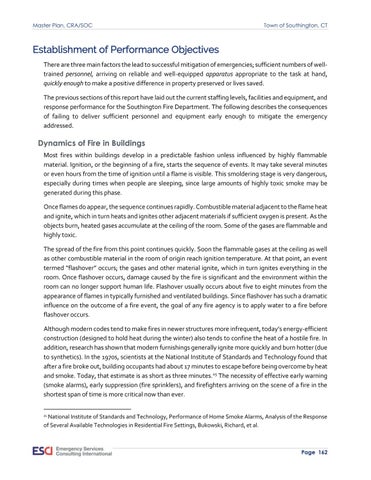Master Plan, CRA/SOC
Town of Southington, CT
Establishment of Performance Objectives There are three main factors the lead to successful mitigation of emergencies; sufficient numbers of welltrained personnel, arriving on reliable and well-equipped apparatus appropriate to the task at hand, quickly enough to make a positive difference in property preserved or lives saved. The previous sections of this report have laid out the current staffing levels, facilities and equipment, and response performance for the Southington Fire Department. The following describes the consequences of failing to deliver sufficient personnel and equipment early enough to mitigate the emergency addressed.
Dynamics of Fire in Buildings Most fires within buildings develop in a predictable fashion unless influenced by highly flammable material. Ignition, or the beginning of a fire, starts the sequence of events. It may take several minutes or even hours from the time of ignition until a flame is visible. This smoldering stage is very dangerous, especially during times when people are sleeping, since large amounts of highly toxic smoke may be generated during this phase. Once flames do appear, the sequence continues rapidly. Combustible material adjacent to the flame heat and ignite, which in turn heats and ignites other adjacent materials if sufficient oxygen is present. As the objects burn, heated gases accumulate at the ceiling of the room. Some of the gases are flammable and highly toxic. The spread of the fire from this point continues quickly. Soon the flammable gases at the ceiling as well as other combustible material in the room of origin reach ignition temperature. At that point, an event termed “flashover” occurs; the gases and other material ignite, which in turn ignites everything in the room. Once flashover occurs, damage caused by the fire is significant and the environment within the room can no longer support human life. Flashover usually occurs about five to eight minutes from the appearance of flames in typically furnished and ventilated buildings. Since flashover has such a dramatic influence on the outcome of a fire event, the goal of any fire agency is to apply water to a fire before flashover occurs. Although modern codes tend to make fires in newer structures more infrequent, today’s energy-efficient construction (designed to hold heat during the winter) also tends to confine the heat of a hostile fire. In addition, research has shown that modern furnishings generally ignite more quickly and burn hotter (due to synthetics). In the 1970s, scientists at the National Institute of Standards and Technology found that after a fire broke out, building occupants had about 17 minutes to escape before being overcome by heat and smoke. Today, that estimate is as short as three minutes.25 The necessity of effective early warning (smoke alarms), early suppression (fire sprinklers), and firefighters arriving on the scene of a fire in the shortest span of time is more critical now than ever. National Institute of Standards and Technology, Performance of Home Smoke Alarms, Analysis of the Response of Several Available Technologies in Residential Fire Settings, Bukowski, Richard, et al. 25
Page 162












